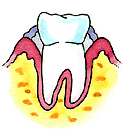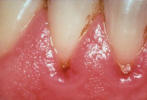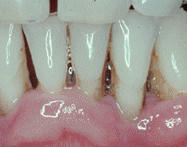
Types of Gum Disease
Periodontal diseases include any type of bacterial infection affecting the gingival tissues (gums) surrounding and supporting our teeth.
We can distinguish two main types of gum disease:
(i) Gingivitis and (ii) Periodontitis
Gingivitis & Periodontitis (main types of gum disease)
Gingivitis
 Gingivitis is the mildest type of periodontal disease and usually represents the first stage of gum disease. Most common symptoms include red, tender or/and swollen gums that may tend to bleed easily when brushing or flossing teeth.
Gingivitis is the mildest type of periodontal disease and usually represents the first stage of gum disease. Most common symptoms include red, tender or/and swollen gums that may tend to bleed easily when brushing or flossing teeth.
Gingivitis is not associated with loss of gum attachment from teeth or with bone loss. This type of periodontal disease can be easily reversed with professional dental cleaning and proper daily oral hygiene.
Periodontitis
 Periodontitis is considered as the more serious form of gum disease because it can cause irreversible damage to oral tissues.
This type of periodontal disease is characterized by loss of attachment of gingival tissues from teeth and by bone loss at the infected area.
Periodontitis is considered as the more serious form of gum disease because it can cause irreversible damage to oral tissues.
This type of periodontal disease is characterized by loss of attachment of gingival tissues from teeth and by bone loss at the infected area.
Deep pockets form between the teeth and the gums. Receding gums that bleed easily and bad breath are common symptoms of periodontitis.
In advanced stages, periodontitis can lead to the destruction of the soft and hard tissues that support teeth and can finally result in tooth loss.
Types of periodontitis (advanced gum disease)
Periodontitis can be classified in several sub-types based on differences regarding bacterial etiology, host response and clinical disease progression. According to the American Academy of Periodontology, there are three types of periodontitis depending on the manifestation of the periodontal disease:
Chronic periodontitis
Chronic periodontitis (a.k.a. adult periodontitis) is the most frequent type of periodontitis and is characterized by pocket formation and slowly progressing gum recession. The condition may first appear in adolescence due to poor oral hygiene but in most cases it is after mid-30s when the clinical symptoms become significant. If chronic periodontitis symptoms are ignored, the loss of bone and gum tissue will lead to tooth loss. It can be further divided into 3 stages; early, moderate and advanced stage.
Aggressive periodontitis
Aggressive periodontitis (a.k.a. early onset periodontitis) is a dangerous type of periodontal disease that can cause tooth loss in a short period of time. Common symptoms are the fast increase in the depth of periodontal pockets and the rapid loss of bone structure.
Sometimes the condition is localized affecting one or no more than 3 teeth in patients with good oral health. Generalized aggressive periodontitis affecting the whole mouth requires immediate treatment to prevent extensive tooth loss. Genetic factors and immune deficiencies are considered as causes of aggressive periodontitis in addition to the microbial etiology of gum disease.
Depending on the age when the condition first appears it used to be classified as:
- Pre-puberty AP is a rare type of periodontal disease found in children less than 12 years old that can cause the loss of primary and/or permanent teeth. The disease is usually related to genetic disorders and may appear with the eruption of the first primary teeth.
- Juvenile periodontitis begins at puberty and is defined by severe bone loss commonly limited around the first molars and incisors. It is more aggressive than other types of periodontal disease causing very rapid vertical bone loss across the teeth roots. Juvenile periodontitis is usually asymptomatic without the usual symptoms of gum disease such as gums inflammation or gum bleeding.
- Rapidly progressive periodontitis occurs in the early 20s to mid-30s. Severe inflammation and rapid bone and connective tissue loss occur, and tooth loss is possible within a year of onset.
The goal of treatment in aggressive periodontitis is to fight the microbial etiology and (if possible) the contributing risk factors. Treatment methods are similar to those used for chronic periodontitis, including oral hygiene, tooth scaling and root planing, and periodontal gum surgery if needed.
Periodontitis as a Manifestation of Systemic Diseases
Periodontitis as a manifestation of systemic diseases is more often associated with younger age patients. Systemic conditions such as heart disease, leukemia, respiratory disease, and diabetes or disorders such as Down syndrome are associated with this form of periodontal disease.
A medical examination is required in cases of early-onset periodontitis to identify the presence of any systemic disease that might have triggered the periodontal disease.
Other types of periodontal diseases
Acute Necrotizing Ulcerative Gingivitis
Acute Necrotizing Ulcerative Gingivitis (ANUG) is a severe and painful type of periodontal disease, which causes deep ulcerations of the gingival tissues. The condition is usually triggered by poor oral hygiene and poor nutrition. If left without treatment, the bacterial infection can lead to the necrosis of gum tissues and may spread to other areas of the body.
Acute Necrotizing Ulcerative Gingivitis is a much more severe condition than normal gingivitis, causing open gum sores and finally the death of the gum tissue.
Pregnancy gingivitis
Pregnancy gingivitis is one of the most common dental problems during pregnancy. The condition is directly associated with the hormonal changes in the body of pregnant women.
Pericoronitis
Pericoronitis is a common dental problem of the gums in young adults at the age of 17-24 when the wisdom teeth normally erupt (break through the gum) in the mouth. It is a painful inflammation caused by the infection of the soft gingival tissues (gums) over or around a partially erupted tooth, most often a wisdom tooth.
Periodontal-endodontic lesions
Periodontal-endodontic lesions are another type of periodontitis that is related with infected hard tooth tissues except of the gums. In this condition an infection from a decayed tooth root may spread to the adjacent bone and gum tissues creating deep pockets around the tooth and leading to bone loss.
Desquamative gingivitis
One of the most painful but rare types of periodontal disease is a condition called desquamative gingivitis. The outer layers of the gums separate from the underlying tissue and peel away, exposing the inner layers and causing acute pain. This type of gum is more common in women after menopause.
All types of periodontal disease can cause, sooner or later, severe loss of gingival and bone tissues leading to tooth loss. It is important that you visit your dentist or periodontist at the first signs of gum disease.

